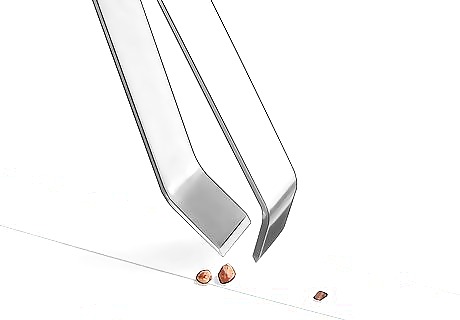
views
Removing Ear Mites from Bedding

Wash your pet's bedding. Ear mites are contagious, especially to other pets. It is important to wash your pet's bedding in order to keep your pet from getting reinfected and from infecting any other pets you might have. Use hot soapy water to wash your pet's bedding. Follow the manufacturer's instructions! Some bedding can simply be thrown in the washing machine, while others must be washed by hand.

Wash any bedding and any other blankets your pet comes into contact with. While ear mites don't live long when not inside your pet's ear, it is best to make sure all your bedding and blankets are clean and ear mite free. Wash them in hot soapy water.

Spray your pet's bedding. There are products available meant to kill fleas, ticks, and mites on household surfaces. If you are still worried about mites infecting your pets bedding, spray them with a product that will be sure to kill them.
Using Medication

Get ear mite medication from your veterinarian or a reputable store. The medication used for ear mites is a pesticide designed to kill the mites. Be sure to read the manufacturer's instructions before proceeding, as they will provide important information about how much medication to apply. Don't use ear mite medication in your pet's ears if your pet has pupils of different sizes or has a head tilt they cannot correct on their own. If this is the case, there is a good chance that the eardrum is ruptured, and you don't want to place anything inside the ears that will make things worse. Consult your veterinarian right away.

Clean out as much of the dark buildup in the ear as you can. Medication works best if the ears are clean before it is applied. Therefore, take the time to clean any build up out of your pets ears. Use a few drops of mineral oil in the ear canal; it will help break up the crumbly material when you massage the ear canal. Use a cotton ball to wipe out debris after your pet shakes its head. After you clean its ears, your pet may try to scratch the ear. Do your best to prevent the scratching by using a towel to block your pet's ability to reach its ears. An Elizabethan collar (aka e-collar) may be needed temporarily to protect your pet from self-trauma.

Apply the medication. Begin by holding the pet's head firmly in your hand, which will prevent the pet from shaking its head and dispersing the medication as you're trying to apply it. Tip the bottle or vial over and insert the applicator tip carefully into the ear. Squeeze the bottle until the proper amount of medication is deposited. The medication is more effective if you apply it deep into the ear canal. Note that your pet will probably shake its head after application, so you may want to administer the treatment outdoors or in the bathroom or laundry room to prevent the medication from getting on your furniture.

Massage your pet's ears. Once you have placed ear medication in the first ear, start massaging right away while you place medication in the second ear. Gently squeeze the ear closed and use your fingers to massage the medicine thoroughly in the ear. Massage by using your thumb and forefinger on either side of the canal, just below the opening to the ear canal. Open and close your fingers together and you will hear a squishing sound. Most of the time, massaging the first ear keeps the pet occupied quite nicely so you can get to the second ear relatively calmly. Although one person can accomplish this treatment, it always helps to have another set of hands at the ready just in case.

Wipe away any excess. If there's any excess medication, wipe it away gently with a clean towel. This step is particularly helpful if you're concerned about your pet getting medication on carpets or furniture.

Repeat the treatment. It is unlikely that you will kill all of the mites in one treatment. Follow the medication's instructions. Typically, you will treat the mites once daily for seven days.
Determining if Your Pet Has Ear Mites

Look for redness and irritation. The inside of the ear will be red and irritated; however, while a red irritated ear can be a sign of ear mites, that in and of itself isn't a definitive symptom. If you don't see any other ear-mite symptoms or have any doubt, see your vet. Not all red and irritated ear canals are due to ear mites. Ear infections involving bacteria and yeast are quite common, particularly in dogs. These ear infections will not respond to ear mite treatment. Your veterinarian can determine whether ear mites are involved and, if they are not, prescribe the appropriate remedy for your pet. Treating your pet with the wrong product may do more harm than good.

Take and inspect a sample from the pet's ear. If you suspect your pet has ear mites, you may be able to see the parasite with your naked eye. Carefully remove a small sample of the dark brown/black debris (it should look like coffee grounds) from the ear canal with a cotton ball. You may need to add a few drops of mineral oil to the material in the ear and massage to help loosen it up to get a sample. Your pet may shake its head after you've placed the mineral oil in its ear and likely some chunks will fly out. You can then inspect those samples. Look at the sample material in bright light and see if you can find tiny white “dots.” They may even move. Those are likely ear mites. If you can't see any in a bright light, try again in low light — it may be harder for you to see, but mites hide from light, so they may not be visible under the bright light.

Take your pet to the veterinarian. The best way to know for sure that your pet has ear mites is to have your veterinarian do an exam and look at a sample of the material from the ear canal under the microscope. Note that cats are far more prone to ear mites than dogs, but dogs can occasionally get them, particularly if there is a cat in the same household that has mites. The vet may place long-acting ear mite medication in your pet's ears for you and send you home with something to help with the itching. It is not uncommon for a secondary bacterial or yeast infection to be present with the ear mites, so medication to treat that may be sent home as well.
















Comments
0 comment